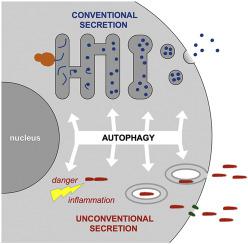当前位置:
X-MOL 学术
›
J. Mol. Biol.
›
论文详情
Our official English website, www.x-mol.net, welcomes your feedback! (Note: you will need to create a separate account there.)
Autophagy and Protein Secretion.
Journal of Molecular Biology ( IF 5.6 ) Pub Date : 2020-01-21 , DOI: 10.1016/j.jmb.2020.01.015 Giulio Cavalli 1 , Simone Cenci 2
Journal of Molecular Biology ( IF 5.6 ) Pub Date : 2020-01-21 , DOI: 10.1016/j.jmb.2020.01.015 Giulio Cavalli 1 , Simone Cenci 2
Affiliation

|
Autophagy - conventional for macroautophagy - is a major recycling strategy that ensures cellular homeostasis through the selective engulfment of cytoplasmic supramolecular cargos in double membrane vesicles and their rapid dispatch to the lysosome for digestion. As autophagy operates in the cytoplasm, its interference with secretory proteins, that is, proteins destined to the plasma membrane or the extracellular space, generally synthesized and routed within the endoplasmic reticulum (ER), has been relatively overlooked in the past. However, mounting evidence reveals that autophagy in fact heavily regulates protein secretion through diverse mechanisms. First, autophagy is closely involved in the unconventional secretion of leaderless proteins, a pool of proteins destined extracellularly, but lacking an ER-targeted leader sequence, and thus manufactured in the cytosol. Autophagy-related (ATG) genes now appear instrumental to the underlying pathways, hence the recently coined concept of secretory autophagy, or better ATG gene-dependent secretion. Indeed, ATG genes regulate unconventional protein secretion at multiple levels, ranging from intracellular inflammatory signaling, for example, through the control of mitochondrial health and inflammasome activity, to trafficking of leaderless proteins. Moreover, perhaps less expectedly, autophagy also participates in the control of conventional secretion, intersecting the secretory apparatus at multiple points, though with surprising differences among professional secretory cell types that disclose remarkable and unpredicted specificity. This review synopsizes the multiple mechanisms whereby autophagy interfaces with conventional and unconventional protein secretory pathways and discusses the relative teleology. Altogether, the diverse controls exerted on protein secretion broaden and deepen the homeostatic significance of autophagy within the cell.
中文翻译:

自噬和蛋白质分泌。
自噬是大分子自噬的常规方法,是一种主要的回收策略,可通过将细胞质超分子货物选择性吞噬在双膜小泡中并快速分配到溶酶体中进行消化来确保细胞稳态。由于自噬在细胞质中发挥作用,因此过去人们通常忽略了它对分泌蛋白的干扰,分泌蛋白是发往质膜或细胞外空间的蛋白,通常在内质网(ER)内合成和传递。但是,越来越多的证据表明,自噬实际上是通过多种机制严重调节蛋白质分泌的。首先,自噬与无前导蛋白的非常规分泌密切相关,无前导蛋白是细胞外注定的蛋白池,但缺少针对ER的前导序列,因此在胞质溶胶中制造。自噬相关(ATG)基因现在似乎对基础途径起作用,因此是最近提出的分泌自噬或更好的ATG基因依赖性分泌概念。确实,ATG基因在多个水平上调节非常规蛋白质的分泌,从细胞内炎症信号传导,例如通过控制线粒体健康和炎症小体活性,到无前导蛋白的运输。而且,自噬也参与了常规分泌的控制,在多个点上与分泌装置相交,尽管在专业分泌细胞类型之间令人惊讶的差异显示出显着的和不可预测的特异性。这篇综述概述了自噬与常规和非常规蛋白分泌途径相互作用的多种机制,并讨论了相关的目的论。总而言之,对蛋白质分泌施加的各种控制作用加宽并加深了细胞内自噬的体内平衡作用。
更新日期:2020-01-21
中文翻译:

自噬和蛋白质分泌。
自噬是大分子自噬的常规方法,是一种主要的回收策略,可通过将细胞质超分子货物选择性吞噬在双膜小泡中并快速分配到溶酶体中进行消化来确保细胞稳态。由于自噬在细胞质中发挥作用,因此过去人们通常忽略了它对分泌蛋白的干扰,分泌蛋白是发往质膜或细胞外空间的蛋白,通常在内质网(ER)内合成和传递。但是,越来越多的证据表明,自噬实际上是通过多种机制严重调节蛋白质分泌的。首先,自噬与无前导蛋白的非常规分泌密切相关,无前导蛋白是细胞外注定的蛋白池,但缺少针对ER的前导序列,因此在胞质溶胶中制造。自噬相关(ATG)基因现在似乎对基础途径起作用,因此是最近提出的分泌自噬或更好的ATG基因依赖性分泌概念。确实,ATG基因在多个水平上调节非常规蛋白质的分泌,从细胞内炎症信号传导,例如通过控制线粒体健康和炎症小体活性,到无前导蛋白的运输。而且,自噬也参与了常规分泌的控制,在多个点上与分泌装置相交,尽管在专业分泌细胞类型之间令人惊讶的差异显示出显着的和不可预测的特异性。这篇综述概述了自噬与常规和非常规蛋白分泌途径相互作用的多种机制,并讨论了相关的目的论。总而言之,对蛋白质分泌施加的各种控制作用加宽并加深了细胞内自噬的体内平衡作用。


























 京公网安备 11010802027423号
京公网安备 11010802027423号